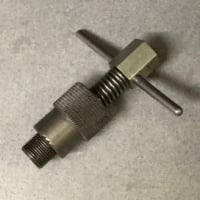Welcome! Here are the website rules, as well as some tips for using this forum.
Need to contact us? Visit https://heatinghelp.com/contact-us/.
Click here to Find a Contractor in your area.
Need info on black pipe installation for a new twin boiler install
Options
DCastle
Member Posts: 15
in Gas Heating
Hello: To summarize my situation, I'm plumbing my heating system with twin conventional high-mass boilers. The system is a converted gravity system and I'm using information aquired from Dan Holohan's book "Primary and Secondary Pumping made Easy". Mr. Holohan's book's by the way, have been a excellent resource for me... The system uses the system of splitting the heat load between two boilers to save on fuel consumption. My approximate heat load is 120k Btu, based upon my (Minnesota) design temperature of -20 below. At that time of the year, say between January and February; both boilers will be operating, and typically that is the only time of the heating season both boilers will be needed for the load: for the remainder of the season one boiler will suffice.
I'm a machinist by trade, I'm not a professional, thats why I'm seeking your advice. For app. 40 years now I've built and maintained my hydronic systems myself using your help... Most of my past experience has been with sweating copper pipe and fittings for the install. This time I want to use black pipe and forged fittings for the project, because of it's ruggedness and ease of changeover for future modifications and repairs. I just think it looks more professional, it's rugged, and directly compatible with my exsisting 111 year old black pipes and fittings. I have all the tools neccessary, but lack some of the neccessary knowledge for the project. I know how how to thread pipe and (of course) how to use pipe wrenches, but I need advice on proper placement of unions. I need to know of a good supplier of 150lb forged fittings, and I would't object to buying some NOS pipe fittings if anyone has them for sale via mail. Your future help will be greatly appreciated.
Thankyou,
Dale Wilson
I'm a machinist by trade, I'm not a professional, thats why I'm seeking your advice. For app. 40 years now I've built and maintained my hydronic systems myself using your help... Most of my past experience has been with sweating copper pipe and fittings for the install. This time I want to use black pipe and forged fittings for the project, because of it's ruggedness and ease of changeover for future modifications and repairs. I just think it looks more professional, it's rugged, and directly compatible with my exsisting 111 year old black pipes and fittings. I have all the tools neccessary, but lack some of the neccessary knowledge for the project. I know how how to thread pipe and (of course) how to use pipe wrenches, but I need advice on proper placement of unions. I need to know of a good supplier of 150lb forged fittings, and I would't object to buying some NOS pipe fittings if anyone has them for sale via mail. Your future help will be greatly appreciated.
Thankyou,
Dale Wilson
0
Comments
-
Sounds great! I like old school.
- Do you have a lead-lag control in mind to control the boilers?
- What model boilers will you be using? They must be very small, i.e. 80,000 BTU each?
8.33 lbs./gal. x 60 min./hr. x 20°ΔT = 10,000 BTU's/hour
Two btu per sq ft for degree difference for a slab0 - Do you have a lead-lag control in mind to control the boilers?
-
Also, and again: this is to everyone: Maybe there is a good book on plumbing with black pipe and fittings? Or maybe some source online? Thanks, Dale0
-
I wouldn't use forged fittings they would be very expensive.
Personally for water I would use sweat copper but black fittings are fine. Your old system probably has cast iron fittings and malleable iron fittings are also acceptable. Any reputable P & H supply house in your area should have the right fittings. Personally I would stay away from the big box stores and Chinease fittings and look for Ward or Anvil brand fittings
So if you know how to thread and use wrenches what information are you looking for? Seems to me you need a piping diagram0 -
There was a time when splitting the load between two boilers made sense, but with the advent of modulating gas valves, I don't see it done, at least, not on a small residential scale.
Having never installed two boilers on one system before, I can only tell you the small amount of information I've gleaned over the years and perhaps others with more experience will chime in where I've fallen short.
Ideally, you turn on one boiler on a call for heat and if that boiler can't reach setpoint, the other boiler is fired. A 2-stage thermostat can do this by sensing the time it takes the air temperature to respond to a call for heat. Alternatively, a lead-lag boiler control can do this by monitoring the return water temperature. The benefit of a lead-lag control is that it will alternate boilers to reduce wear.8.33 lbs./gal. x 60 min./hr. x 20°ΔT = 10,000 BTU's/hour
Two btu per sq ft for degree difference for a slab0 -
Read thru these. You'll have all the info you could possibly need:
https://www.caleffi.com/usa/en-us/technical-magazineThere was an error rendering this rich post.
1 -
Thanks so much again, Alan: I decided on two high-mass boilers as opposed to a condensing boiler for a few reasons: As I've said before, I'm a home handyman, and I lack experience with modern mod-con condensing boilers, also they are relatively new (especially compared to high mass boilers, that have been around for app 150 yrs). They are extremely expensive, I've heard that they have component failure problems sometimes semi-annually on the order of $200-400 and they are somewhat noisy. Also, I mentioned before, my system is 111 year old converted gravity system with 137 gallons of very diry, rusty water and I don't feel (even with my Spiro-Trap) that circulating this water through narrow "heat-exchanger" passages is a wise idea. I bought these two boilers from private sellers, some three years ago, and, at least at that time (on a Heating Help post somewhere) my opinions on high mass vs. low mass boilers agreed with about 50 % of the readership.
0 -
@DCastle
Go with what you know!
Lead-Lag is a good idea, but you can set up analog aquastats to keep it simple. If you add a quick connect (extension cord male and female) to the burner control... you can just switch plugs each year to make boiler B the lead boiler in odd years and boiler A in even years.
You got This!
Edward Young Retired
After you make that expensive repair and you still have the same problem, What will you check next?
0 -
Thanks for the encouragement, Ed! I crave simplicity, I like your idea, but I don't grasp it; could you make a sketch- schematic or diagram to help me understand better?
Thanks, Dale0 -
@DCastle
You can make your own lead lag system with 2 aquastats, two spdt switches and 2 relays. I will make a diagram and post it0 -
0
-
Thanks, Ed,
Dale0
Categories
- All Categories
- 87K THE MAIN WALL
- 3.2K A-C, Heat Pumps & Refrigeration
- 57 Biomass
- 425 Carbon Monoxide Awareness
- 112 Chimneys & Flues
- 2.1K Domestic Hot Water
- 5.7K Gas Heating
- 106 Geothermal
- 160 Indoor-Air Quality
- 3.6K Oil Heating
- 70 Pipe Deterioration
- 979 Plumbing
- 6.3K Radiant Heating
- 387 Solar
- 15.4K Strictly Steam
- 3.4K Thermostats and Controls
- 54 Water Quality
- 44 Industry Classes
- 48 Job Opportunities
- 18 Recall Announcements


